The digital technologies have deeply affected the architectural practice over the past 40 years. The shift of the design paradigm caused by the emergence of the CAD, BIM, algorithmic design tools etc, has been thoroughly covered by Mario Carpo in the two volumes of his fundamental research “The digital turn in architecture 1992-2012” (
https://andreaarianoitcaadsaggio.files.wordpress.com/2018/06/digital-turn.pdf
) and “The second digital turn” (
https://mitpress.mit.edu/books/second-digital-turn
). Here we’d like to cover the issue of the influence of the digital on the construction materials and methods. We’ll be reviewing four articles offered within the theory module of the MACAD programme:
- Pacheco-Torgal, J.A. Labrincha. THE FUTURE OF CONSTRUCTION MATERIALS RESEARCH AND THE SEVENTH UN MILLENNIUM DEVELOPMENT GOAL: A FEW INSIGHTS
https://www.dropbox.com/s/84khcrz31b2s6tn/A%20few%20insights%20-%2055622767.pdf?dl=0
- Jan Knippers. The Limits of Simulation: Towards a New Culture of Architectural Engineering Towards a New Culture of Architectural Engineering – 24751448.2017.pdf
- Sascha Bohnenberger, Klaas de Rycke, Agnes Weilandt. LATTICE SPACES. FORM OPTIMISATION THROUGH CUSTOMIZATION OF NON DEVELOPABLE 3D WOOD SURFACES
https://www.dropbox.com/s/85f6cmzcckzuld2/ecaade2011_136.content.pdf?dl=0
- Roland Snooks. Printed Assemblages: A Co-Evolution of Composite Tectonics and Additive Manufacturing Techniques PrintedAssemblagesFabricate-2020.pdf
The first article takes a look at the construction industry and the material science from the environmental perspective. After the general observation of the environmentaly-unfriendly nature of the conventional industrial construction, the authors give the overview of some progressive hi-tech trends helping to reduce the damage to the planet, specifically the use of the nano-technologies in creating the new types of concrete and porous materials
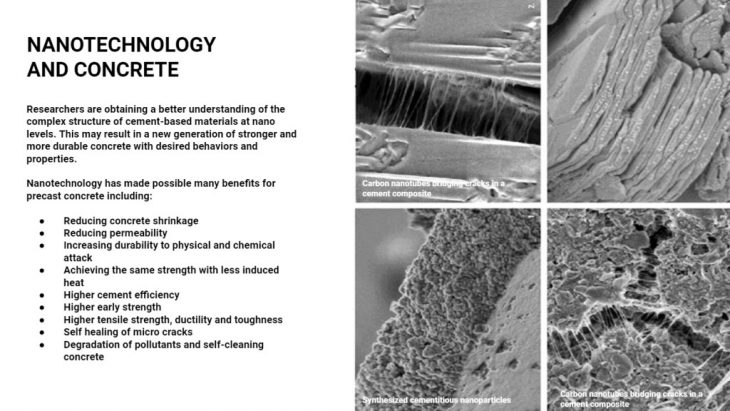
Jan Knippers speculates on the structural simulation methods developed in the late XIXth and XXth centuries as the methodology which has largely defined the aesthetics of the industrial era-architecture, starting from the introduction of the cast iron and through the period of mass-produced standard steel elements. The introduction of the new construction material has first caused the emergence of the spectacular structures but has eventually led to the population of the standardized low-quality projects all over the modern cities. The author then describes the new possibilities of the overall customization which open through the computational design and robotic production of the building elements. He gives the overview of the architectural experiments by prof. Achim Menges and his team: the series of the ICD/ITKE pavilions, annually designed and erected for over 10 years.
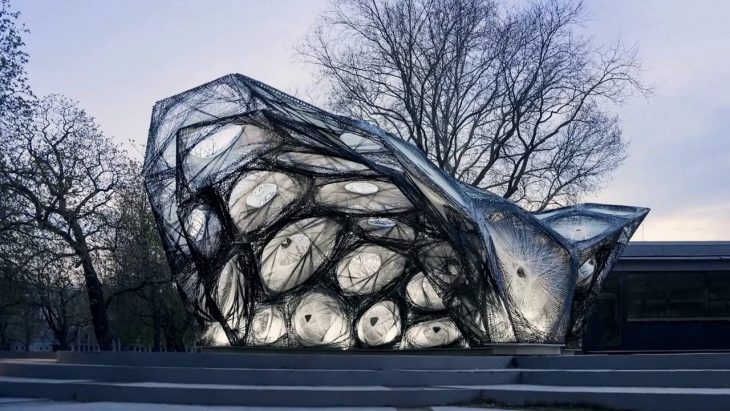
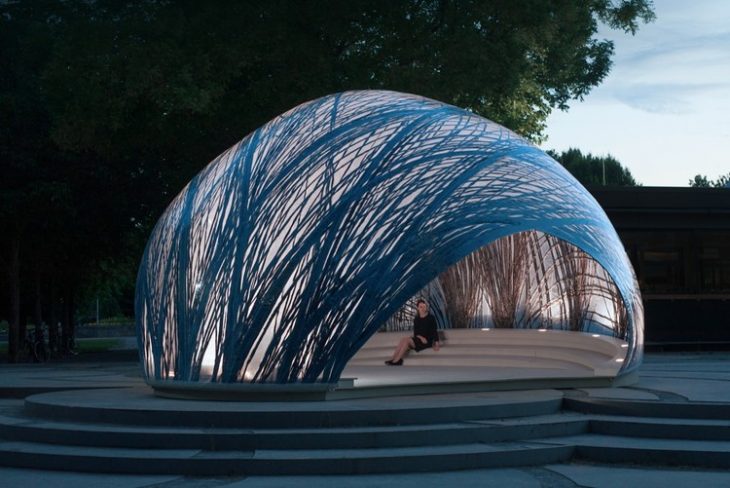
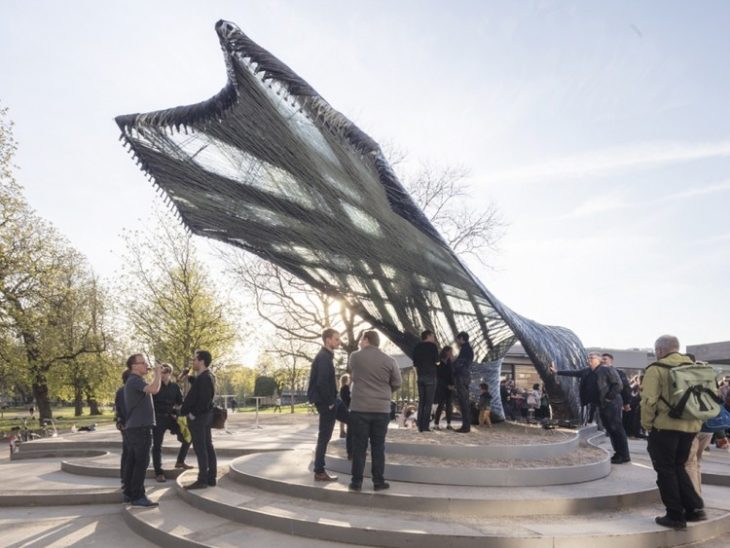
The key features of the Achim Menges’s method are: the interpretation of the original source of inspiration in nature through the biomimetics and the delivery of the design from the computational agent-based model to the physical system through the cyber-phisical fiber placement. Prof. Menges uses online fabrication, fully controlled in real-time.
The third article features the single project, the Hermes boutique in Paris. “The idea was to develop a harmonious dialogue between the origins and the present. The aim was to restore a place that was naturally timeworn but also massively transformed in the mid- 1970s, to make it suitable for public use. We wanted to bring out the qualities of the existing architecture and recapture the spirit of the 1935 swimming pool, while offering a very modern expression of the Hermès spirit at this Left Bank location.” The design is based on the procedurally generated shape which is then assembled of the custom-made steam-bent and milled timber parts. The project is the remarkable example of the digital craftsmanship.
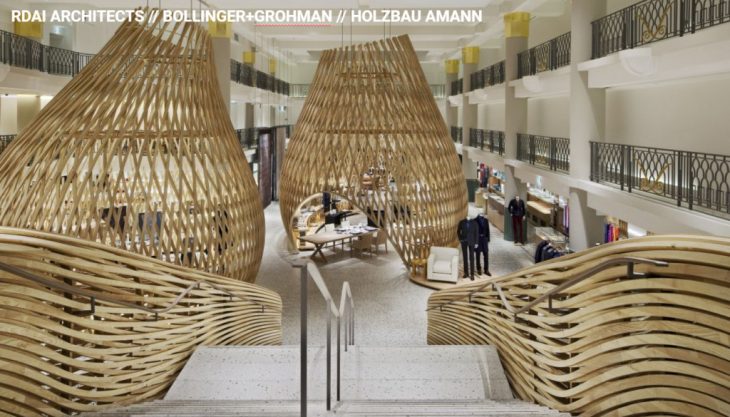
The last article in the selection covers the work of the Roland Snooks studio – the long-term research of the integration of carbon fiberstructural networks within large-scale 3D-printed polymer architectural skins. The article features two works within a lineage of iteratively designed projects that establish a co-evolution of fabrication technique and tectonic logic. The goal is the integration of form, surface and structure through the agent-body generative algorithm and the usage of the fiber-reinforced 3d-printed items as the parts of the assembly kit.
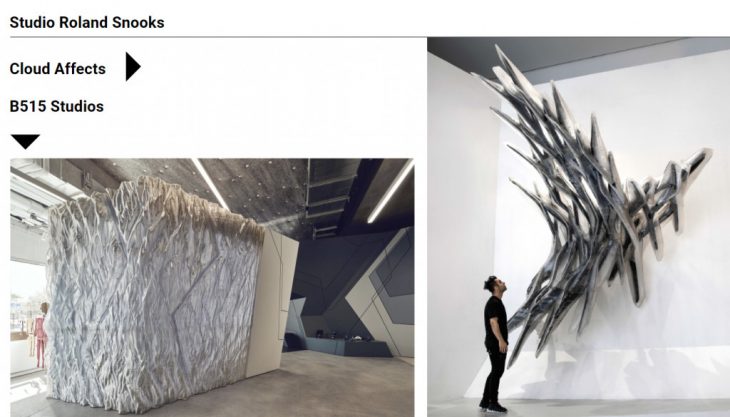
This annotated digest of the reading items provided within the course of Environmental and Structural Design Theory has been created by Amal Algamdey, German Bodenbender and Sergey Kryuchkov, students of the MACAD post-graduate programme. Faculty: Jane Burry. Guest Lecturer on the covered topic: Sascha Bohnenberger
